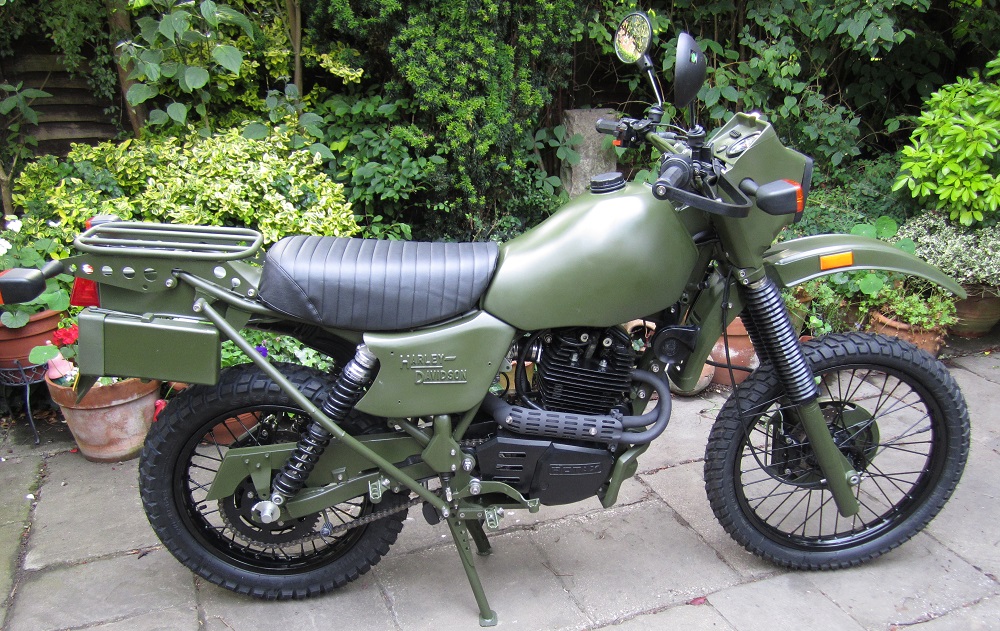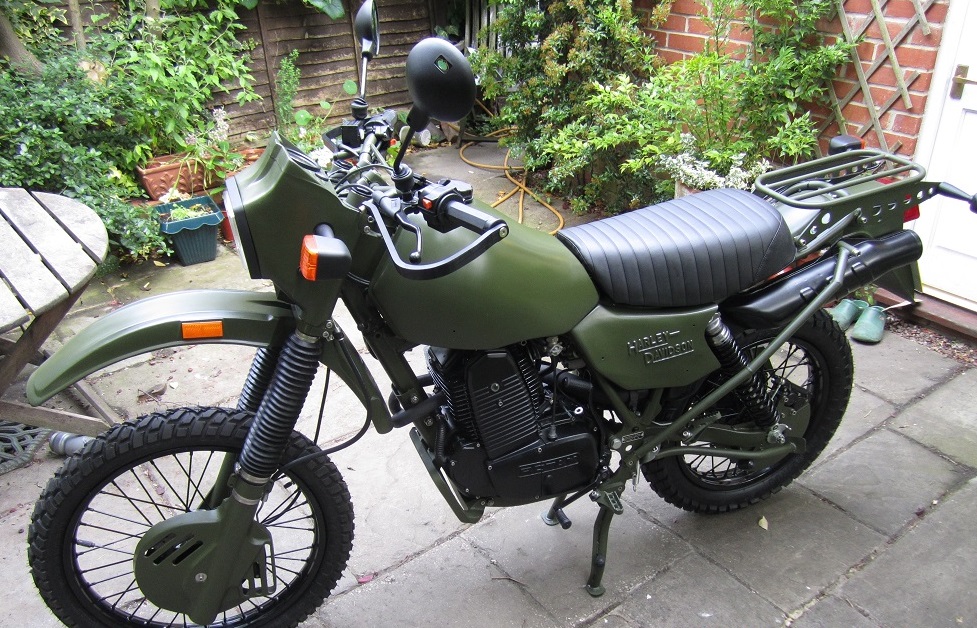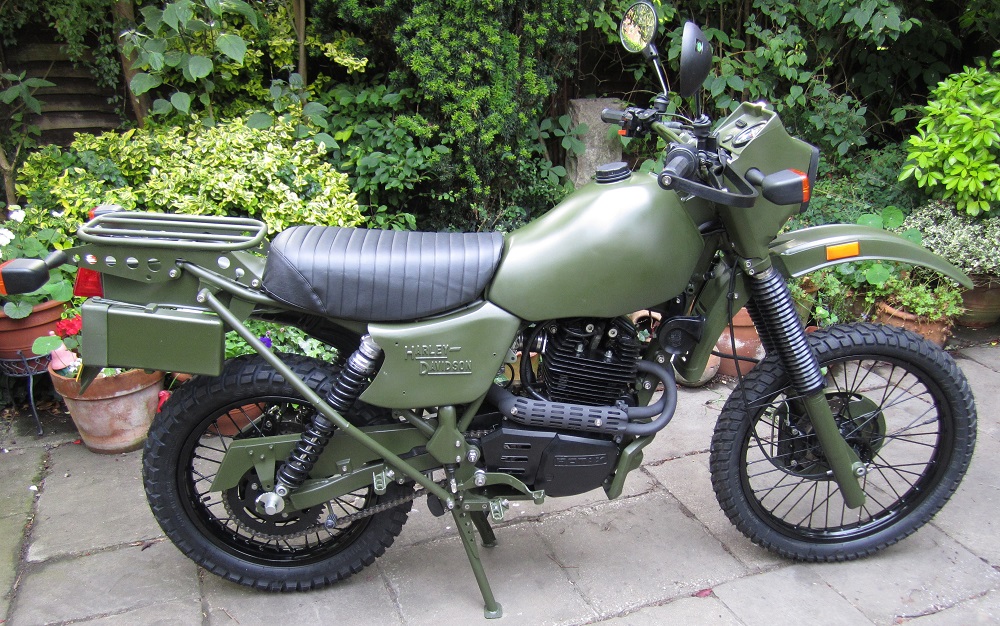The Harley Davidson MT350 motorcycle was built in the USA starting in 1993 and was derived from the earlier Armstrong MT500 built for the British army.
Armstrong motorcycles was set up in Bolton in 1981 having taken control of the former Clews Competition Motorcycles (CCM) founded by Alan Clews. In 1983 they licensed the rights to build the military Can-Am motorcycle in the UK from the Canadian Bombardier company which they then produced until 1987. In 1984 Armstrong-CCM then bought the rights to the Rotax engined XN Tornado from the Milan based SWM company after they had gone into liquidation. From this they developed the Armstrong MT500 and then produced about 3,500 of the bikes for the British Army between 1984 and 1987. They also produced a limited number of MT500’s for the Canadian and Jordanian armies.
However, in 1987, after the MT500 had been adopted as the standard motorcycle for NATO, Armstrong sold the rights to Harley Davidson who took over production in the United States where they produced the Harley Davidson badged MT350 version of the motorcycle. The British Army began buying this version in 1993.
The Harley Davidson MT350 uses an electric start version of the Austrian built Rotax 348cc single cylinder, 4-valve overhead camshaft engine producing 30 bhp and 29 Nm of torque. Although slightly heavy at 162 kg for off-road use, it is a robust motorbike and is fitted with good quality Marzocchi front forks and Ohlin rear shock absorbers. The wheel rims were made by Akront and the hubs by Grimeca. Unlike the MT500 which was fitted with drum brakes, the MT350 was fitted with Grimeca disk brakes front and back. Overall, the bike is well made from an engineering point of view with needle roller swinging arm bearings and taper roller head bearings.
The Rotax engine fitted to the MT350 is fairly bullet proof although the use of a rubber camshaft timing belt mounted inside a metal cover makes the engine sound slightly agricultural at times. This is made more noticeably by the standard silencer, which does a very good job of suppressing the exhaust sound as required on military machines. In fact, the main noise made by the bike when its performance is being pushed hard is the induction sound from the air filter box which, surprisingly, is quite a satisfying noise.
The engine is powered via a Capacitor Discharge Ignition (CDI) unit direct from the generator and is independent of the battery and the lighting system. The power for the lights and other electrical components then comes from separate alternator coils. A blackout switch is fitted on the handlebar to enable the lights to be distinguished quickly.
The MT350 is fitted with detachable plastic pannier boxes mounted on frames either side of the engine. It is also fitted with a plastic rifle scabbard at the back on the right-hand side. Although it is a matter of personal taste, I regard the Armstrong MT500 as a handsome looking machine in a similar way to its BSA B40WD predecessor. However, I do not regard the Harley Davidson MT350 in the same way because of the utilitarian features it incorporates which tends to be a characteristic of some US engineering. This applies in particular to the design of the rear rack and its ugly support struts and the mounting brackets for the pannier boxes. The instrument panel is also not a work of art!
My MT350 Restoration
When I restored my Armstrong MT500 I got the metal parts powder coated in matt NATO Green paint which included the petrol tank. I then spray painted the plastic ware (mudguards, headlight cowl. etc) using NATO Green paint purchased from LMS of Lichfield. Unfortunately, you could see the difference in the two shades of NATO Green although this was not a big problem with an ex-army bike.
However, in restoring my MT350, I decided to spray paint the whole bike using the remaining NATO Green paint I bought from LMS Lichfield. This was straightforward but spray painting the frame and small metal parts is very time consuming and very wasteful in paint. The only part of the bike that was not spray painted was the wheels which were powder coated in satin black.



The MT350 engine was low mileage and ran well without any unusual noises coming from it. Nevertheless, I gave the engine a top end overall to check the valves, pistons and bore which were all in good condition. All that was needed was to re-grind the valve seats and to replace the valve stem seals and the camshaft oil seal. The clutch was also overhauled and the crankshaft and gear shaft oil seals replaced along with the timing belt. As with most well used Rotax engines, the external paint work was in poor condition and so this was stripped off the engine and repainted.
The front parts of the exhaust system were in reasonable condition but were re-painted with heat proof paint. However, the silencer was in poor condition due to rusting but I managed to get a replacement which had already been restored and repainted.
In the case of my Armstrong MT500 and MT560, I like the fact that they came with a rear rack and pannier racks on the sides and, in both cases, they are now fitted with genuine pannier bags. These are incredibly useful for carrying all sorts of gear including tools and the odd Gerry Can of fuel. However, I have never liked the pannier boxes fitted to the MT350 and the gun scabbard originally fitted at the back on the right-hand side which is completely useless for carrying anything other than an SA80 rifle! Although I still have them, I have not fitted any of this kit to my restored MT350.
MT350 Performance
Although the Armstrong MT500 was used by the British Army until replaced by the Harley Davidson badged MT350 in 1993, the change from a 500 c to a 350 cc Rotax engine is difficult to understand. While the MT500 has reasonable performance overall, the MT350 feels under powered despite both producing similar maximum power output on paper. This is mainly because the MT350 produces its power and torque at much higher revs and therefore needs to be worked that much harder to give the performance. As a result, I find the two motorcycles give totally different riding experiences with my preference being the MT500.
MT350 Specifications
- Engine: Single cylinder, SOHC, 4-valve, 4-stroke
- Starting: Electric and kickstart
- Capacity: 348 cc
- Bore/Stroke: 79.5 x 70.4 mm
- Compression Ratio: 9.6:1
- Max Power: 30 bhp
- Max Torque: 29 Nm
- Carburettor: H-D CV Type
- Cooling: Air cooled
- Lubrication: Dry sump
- Ignition: CDI with magnetic pick-up
- Transmission: 5 speed
- Final Drive: Chain
- Front Suspension: Marzocchi oil filled with 270 mm travel
- Rear Suspension: Ohlins nitrogen filled 230 mm travel
- Front Brake: 140 mm drum brake
- Rear Brake: 150 mm drum brake
- Rake/Trail: 25 deg and 92 mm
- Wheel Base: 1.4 m
- Seat Height: 888 mm
- Front Tyre: 90/90-21
- Rear Tyre: 4.00-18
- Ground Clearance: 254 mm
- Dry Weight: 161 kg
- Fuel Tank: 13 L
- Oil Tank: 3.2 L
MT350 Parts Suppliers
There are two very good suppliers of spare parts for both the Armstrong MT500 and the later Harley-Davison MT350: Force Motorcycles near Burton-on-Trent and LMS near Litchfield.
31,885 total views, 4 views today


